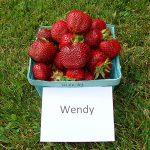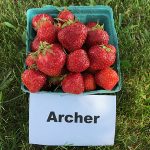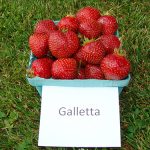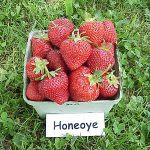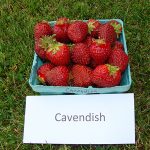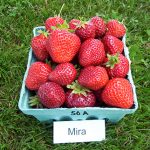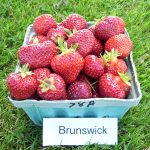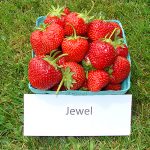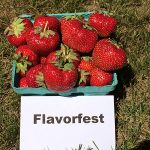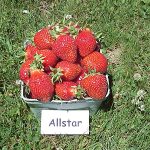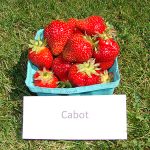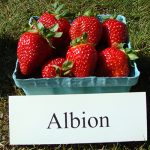Bulletin #2184, Strawberry Varieties for Maine
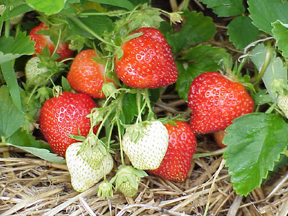 Prepared by David T. Handley, vegetable and small fruit specialist, University of Maine Cooperative Extension, Orono, Maine
Prepared by David T. Handley, vegetable and small fruit specialist, University of Maine Cooperative Extension, Orono, Maine
For information about UMaine Extension programs and resources, visit extension.umaine.edu.
Find more of our publications and books at extension.umaine.edu/publications/.
Table of Contents:
There are a large number of strawberry varieties available to small-scale fruit growers and home gardeners thanks to introductions from numerous both new and established breeding programs in the United States and Canada. Although many new varieties have desirable characteristics, such as large, glossy fruit and high yields, you’ll want to think about other factors before you make a selection. For example,
Ripening season is one factor. Early ripening varieties can bring high prices, but are more susceptible to frost damage, and may not have good yields or high fruit quality. Mid-season berries supply the bulk of the market, but they vary in quality and growth habit. Late-season fruit can be of high quality, but it tends to meet a slower market.
Always start with high-quality planting stock. Poor plant material guarantees a poor planting. Order your plants from a reputable source, and look for nurseries that sell plants from “certified” virus-free stock. Then you can be sure that the plants have been tested by indexing, and found free of common viruses. Virus-free plants have the best growth and productivity. They will also live longer and be more profitable.
Order your plants in the fall or early winter for spring planting to avoid limited supplies. Ask for a shipping date based on the date you plan to plant, usually in May.
Always think about disease resistance when you choose a variety. In New England, red stele (Phytophthora fragariae), a root rot fungus, is common in many soils, especially wet, poor-draining areas. Resistant plants are the best way to combat this disease. Make varieties resistant to red stele a number one choice when you’re ordering strawberry plants. Planting only nonresistant varieties could result in total crop failure, especially in a wet year.
The varieties listed in this publication are good choices for Maine. However, individual varieties may perform differently based on soil type, fertilization, and renovation practices. Always plant several varieties to stretch out the season and prevent disease and frost problems. Also, test varieties in small plots on new sites before committing to a large planting. Despite glowing reviews from a nursery, a variety may not do well because of the particular qualities of your site (for example, poor drainage, short season, low temperatures). Finally, don’t forget your customers. A berry may seem to have everything going for it, but if the customer or your family doesn’t like it, it won’t be very successful.
Early Season
Earliglow:
An early berry of high quality. The fruit is firm with excellent flavor and color. Yields may be low in the Northeast. Fruit size tends to decrease as the season progresses. Plants are vigorous runner producers and are resistant to red stele and verticillium wilt. A favorite with home gardeners.
Wendy: From Nova Scotia. Very early ripening. High-quality, medium-size fruit with good flavor. Yields may be low in the Northeast. Plants are vigorous but can be sensitive to environmental stress. and produce many runners. Some resistance to red stele and foliar diseases.
Archer: A recent release from NY. Early ripening, medium to large fruit with very good flavor. Yields have been low in Maine. Plants have some disease resistance, but may be susceptible to winter injury in colder sites..
Galletta: A recent release from North Carolina. Large, firm fruit; very uniform with good flavor. Good yields, and concentrated ripening. Shy runner producer, but plants are vigorous. A good variety for plasticulture.
Annapolis: From Nova Scotia. Early ripening. High-quality, medium-large fruit with good flavor, but may be tender. Plants are vigorous with some resistance to red stele and foliar diseases.
Early-Midseason
Honeoye: A New York release. Generally early ripening and high yielding. Large, very attractive fruit with firm flesh, but the flavor may be tart or flat. Plants are vigorous and produce many runners. Beds can have good longevity if soils are well-drained. Susceptible to red stele and no known resistance to verticillium.
Cavendish: From Nova Scotia. Productive. Large, firm fruit with good flavor, but with an uneven ripening habit. Long harvest period. Plants are moderately vigorous. Resistant to red stele and verticillium.
Mira: from Nova Scotia. Large, light-red fruit with good quality. Plants have high yield potential and are vigorous with some resistance to red stele root rot and leaf diseases.
Brunswick: From Nova Scotia. Medium to large blocky fruit, attractive, dark red. Somewhat tender, and may be tart if not picked fully ripe. Very high yielding. Plants are vigorous with some resistance to red stele.
Midseason
Jewel: From New York. Productive variety with large, glossy, attractive fruit, and firm texture. Holds well. Plants have moderate vigor and runner production may be susceptible to very cold winters and herbicides. Long harvest season. No known resistance to red stele or verticillium wilt.
Flavorfest: A recent release from the USDA in Maryland. Large, attractive fruit with very good flavor. Fair to good yield. Plants are vigorous and good runner producers. Good variety for plasticulture. Some resistance to red stele and foliar diseases.
Darselect: Originally from France. Large, uniform, attractive fruit, glossy, light red color with large calyxes. Good yields, vigorous plants requiring high fertility. Susceptible to foliar diseases.
Chandler: From California. Medium-large, firm, attractive fruit, long harvest window, good yields. Susceptible to winter injury and root rot diseases. Primarily used for annual plasticulture systems.
Mid-Late Season
Allstar: From the USDA in Maryland. Berries are large, conical, and light red to orange with good flavor. The plants are vigorous but not strong runner producers. Resistant to red stele and verticillium. Tolerant of heavy soils.
Cabot: From Nova Scotia. Very large, but not uniform fruit, bright red, firm, but with tender skin. Good yield. Plants need high fertility to maintain high vigor; beds tend to be short-lived. Plants have some resistance to red stele, but the fruit is susceptible to gray mold.
Sparkle: Excellent flavored, medium-sized fruit, but dark red and somewhat soft. Fruit size tends to decrease as the season progresses. Long harvest season. Plants are vigorous, copious runner producers with some resistance to red stele. A favorite with home gardeners.
Late Season
Clancy: From New York. Large, dark red, round to conic fruit with good firmness, but yields have been low in Maine. Vigorous plants with some resistance to red stele.
Valley Sunset: A recent release from Nova Scotia. Large, uniform fruit with good flavor. Plants show good vigor and runner production. Good variety for plasticulture. Some resistance to foliar diseases.
Day-Neutral
In addition to a spring crop, day-neutral strawberry plants also produce fruit through the late summer and fall (“everbearing”). They are typically grown in annual, plasticulture systems to exploit off-season pricing. Although they can be harvested over a long period of time, overall yields tend to be lower than June-bearing types. These are also good choices for container plantings.
Seascape: From California. Early, late summer-fall ripening. Medium-large, attractive fruit. Flavor can be poor if not allowed to ripen fully on the plants. Productive plants with few runners. Best suited to high-density plasticulture systems. Hardiness may be poor.
Albion: From California. Late ripening, large, very firm, sweet, bright-red fruit. Vigorous plants. Best suited to high-density plasticulture systems.
San Andreas: From California. Late ripening, large, firm dark red fruit with good flavor. Best suited to high-density plasticulture systems
Tristar: From the USDA in Maryland. Medium-sized, bright-red fruit with very good quality. Low vigor plants, with fair productivity. Resistant to red stele and verticillium wilt.
Tribute: From the USDA in Maryland. Medium-sized, bright-red fruit with good quality. Small but vigorous plants producing many runners. Fair to good productivity. Resistant to red stele and verticillium wilt.
| Variety | Ripening Time |
Pest Resistance | Comments |
|---|---|---|---|
| Earliglow | Early | Root rots, leaf spots | Best for home gardens |
| Archer | Early | ||
| Galletta | Early | Root rots, leaf spots | Good for plasticulture |
| Annapolis | Early-midseason | Root rots, leaf spots | |
| Honeoye | Early-midseason | Long picking season | |
| Cavendish | Early-midseason | Root rots, leaf spots | Long picking season |
| Mira | Early-midseason | Root rots, leaf spots | |
| Brunswick | Early-midseason | Root rots, leaf spots | Dark color |
| Jewel | Midseason | High fruit quality | |
| Flavorfest | Midseason | Root rots, leaf spots | |
| Darselect | Midseason | ||
| Chandler | Midseason | For annual plasticulture | |
| Allstar | Mid-late season | Root rots, leaf spots | |
| Cabot | Mid-late season | ||
| Sparkle | Mid-late season | Root rots, leaf spots | Best for home gardens |
| Clancy | Late | ||
| Valley Sunset | Late | ||
| Seascape | Day-neutral | ||
| Albion | Day-neutral | ||
| San Andreas | Day-neutral | ||
| Tristar | Day-neutral | Root rots, leaf spots | Best of home gardens |
| Tribute | Day-neutral | Root rots, leaf spots | Best of home gardens |
Information in this publication is provided purely for educational purposes. No responsibility is assumed for any problems associated with the use of products or services mentioned. No endorsement of products or companies is intended, nor is criticism of unnamed products or companies implied.
© 2008, 2020
Call 800.287.0274 (in Maine), or 207.581.3188, for information on publications and program offerings from University of Maine Cooperative Extension, or visit extension.umaine.edu.
The University of Maine is an EEO/AA employer, and does not discriminate on the grounds of race, color, religion, sex, sexual orientation, transgender status, gender expression, national origin, citizenship status, age, disability, genetic information or veteran’s status in employment, education, and all other programs and activities. The following person has been designated to handle inquiries regarding non-discrimination policies: Director of Equal Opportunity, 101 North Stevens Hall, University of Maine, Orono, ME 04469-5754, 207.581.1226, TTY 711 (Maine Relay System).



